Abstract
Electromyograms (EMGs) were recorded from surface electrodes over the sternomastoid muscles and averaged in response to brief (0.1 ms) clicks played through headphones. In normal subjects, clicks 85 to 100 dB above our reference (45 dB SPL: close to perceptual threshold for normal subjects for such clicks) evoked reproducible changes in the averaged EMG beginning at a mean latency of 8.2 ms. The earliest potential change, a biphasic positive-negativity (p13-n23), occurred in all subjects and the response recorded from over the muscle on each side was predominantly generated by afferents originating from the ipsilateral ear. Later potentials (n34, p44), present in most but not all subjects, were generated bilaterally after unilateral ear stimulation. The amplitude of the averaged responses increased in direct proportion to the mean level of tonic muscle activation during the recording period. The p13-n23 response was abolished in patients who had undergone selective section of the vestibular nerve but was preserved in subjects with severe sensorineural hearing loss. It is proposed that the p13-n23 response is generated by activation of vestibular afferents, possibly those arising from the saccule, and transmitted via a rapidly conducting oligosynaptic pathway to anterior neck muscles. Conversely, the n34 and p44 potentials do not depend on the integrity of the vestibular nerve and probably originate from cochlear afferents.
Full text
PDF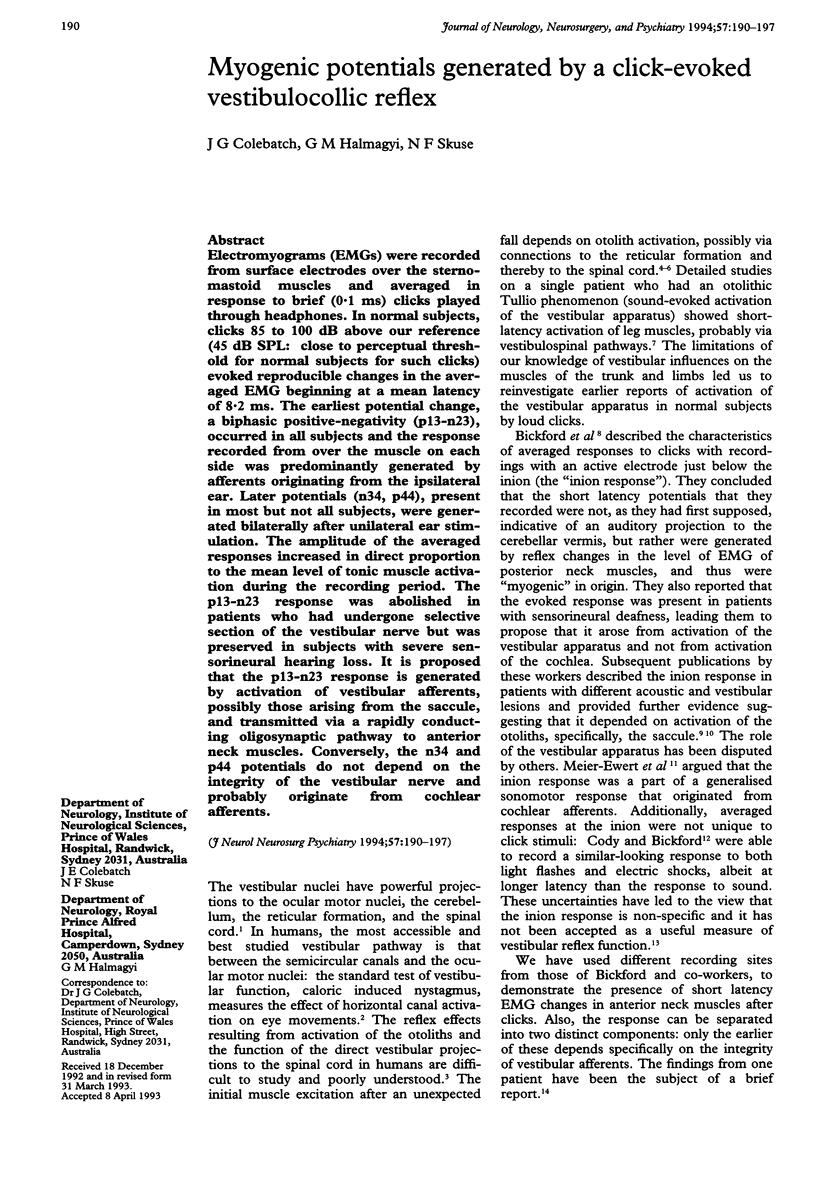
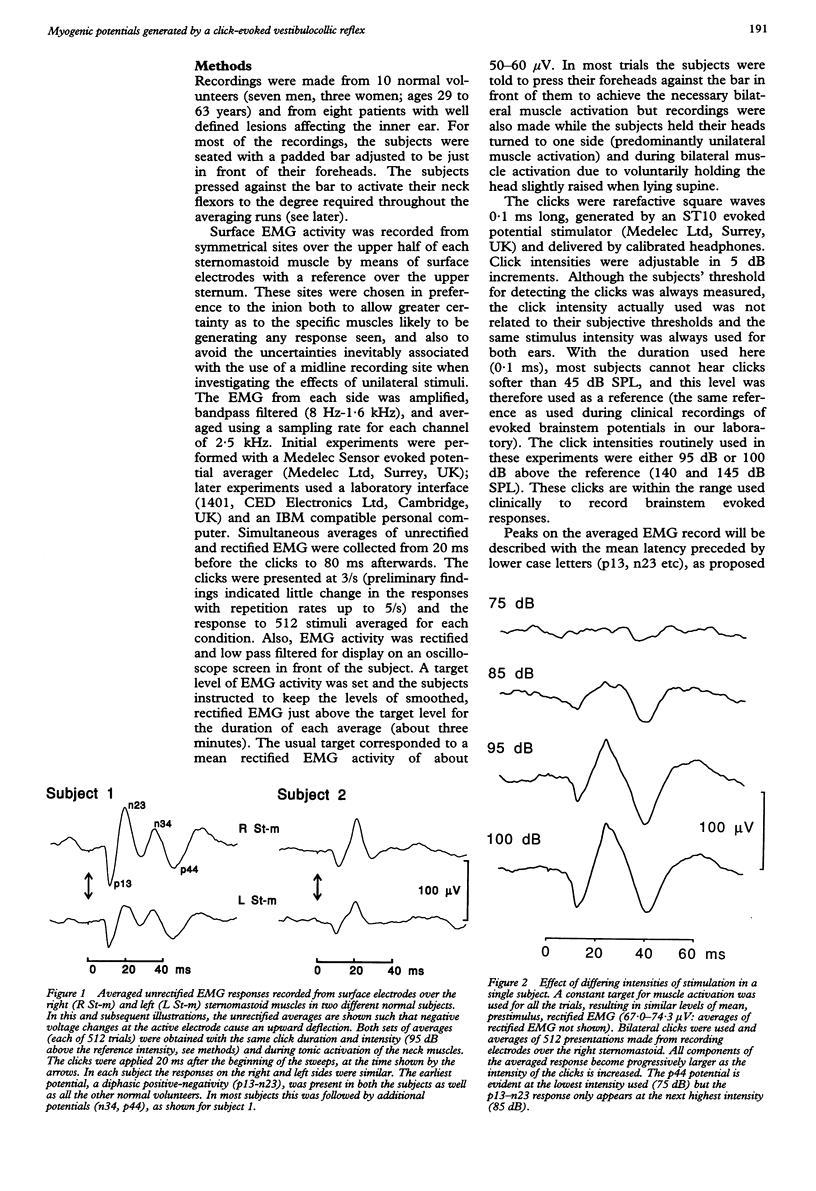
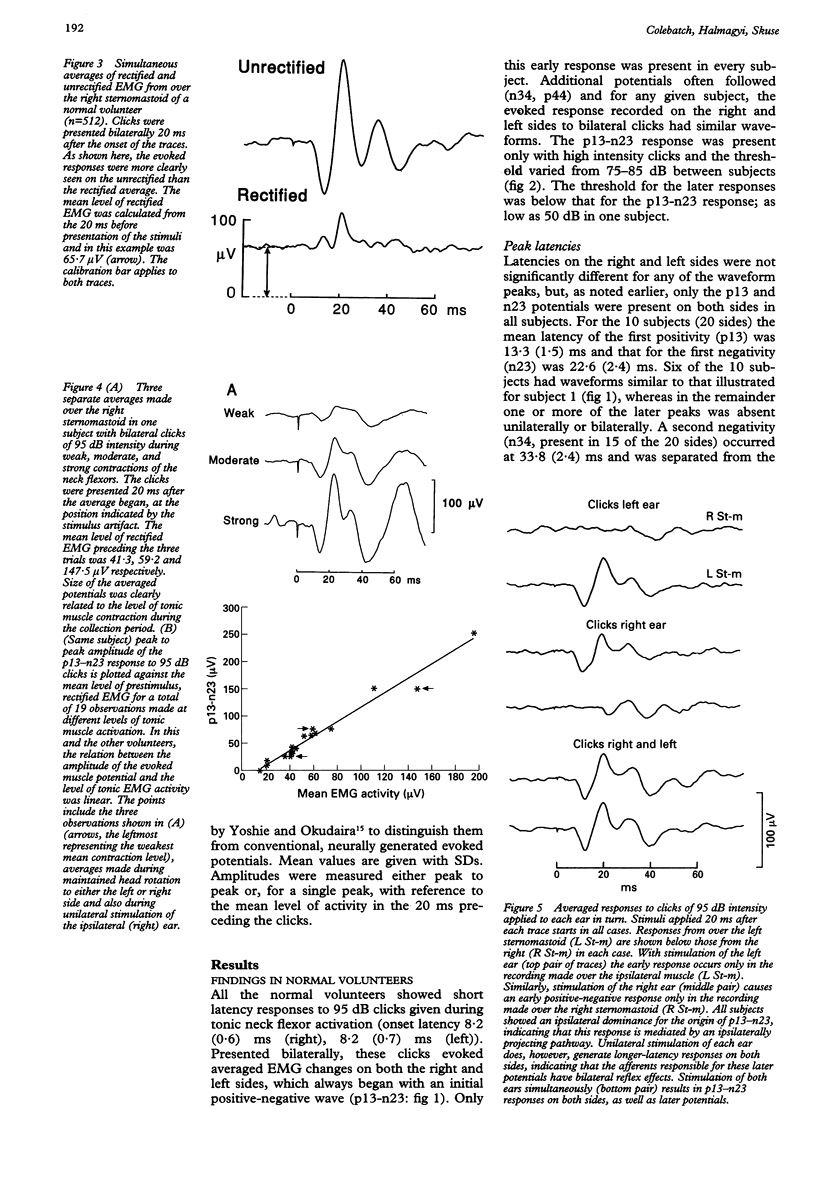
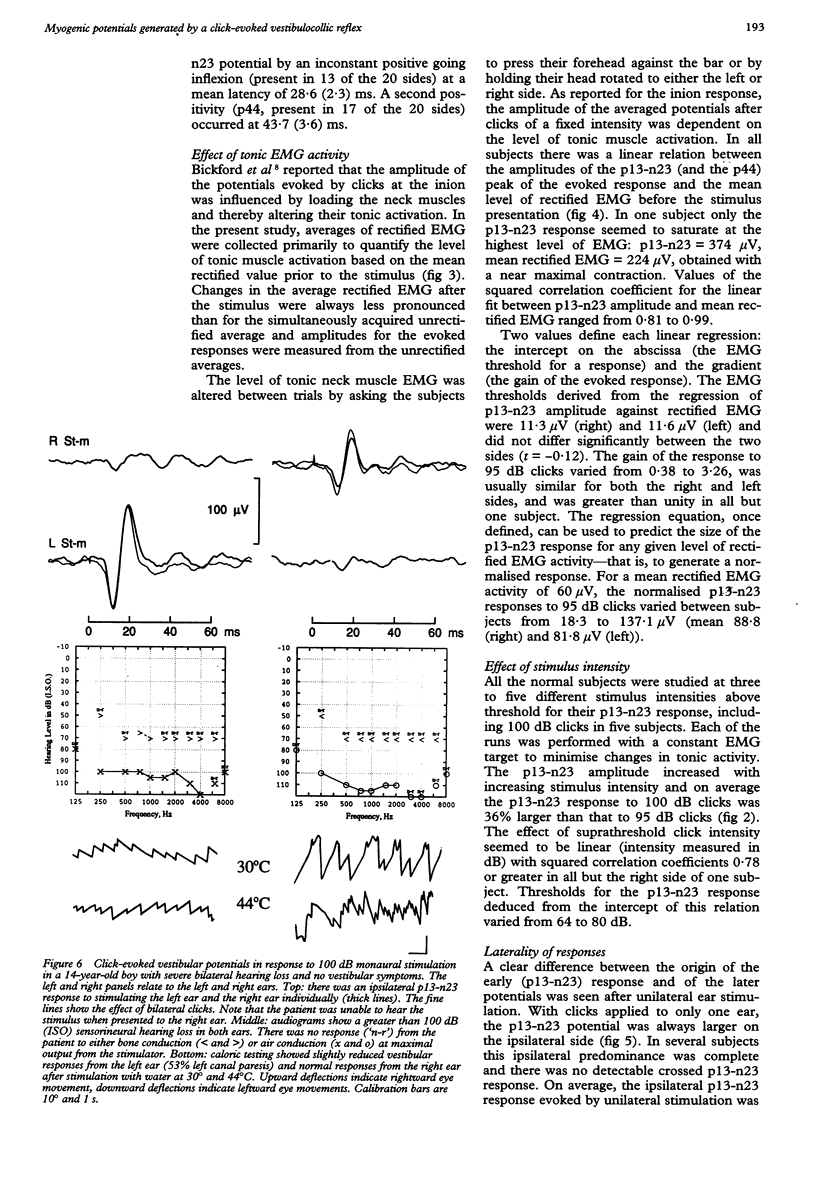
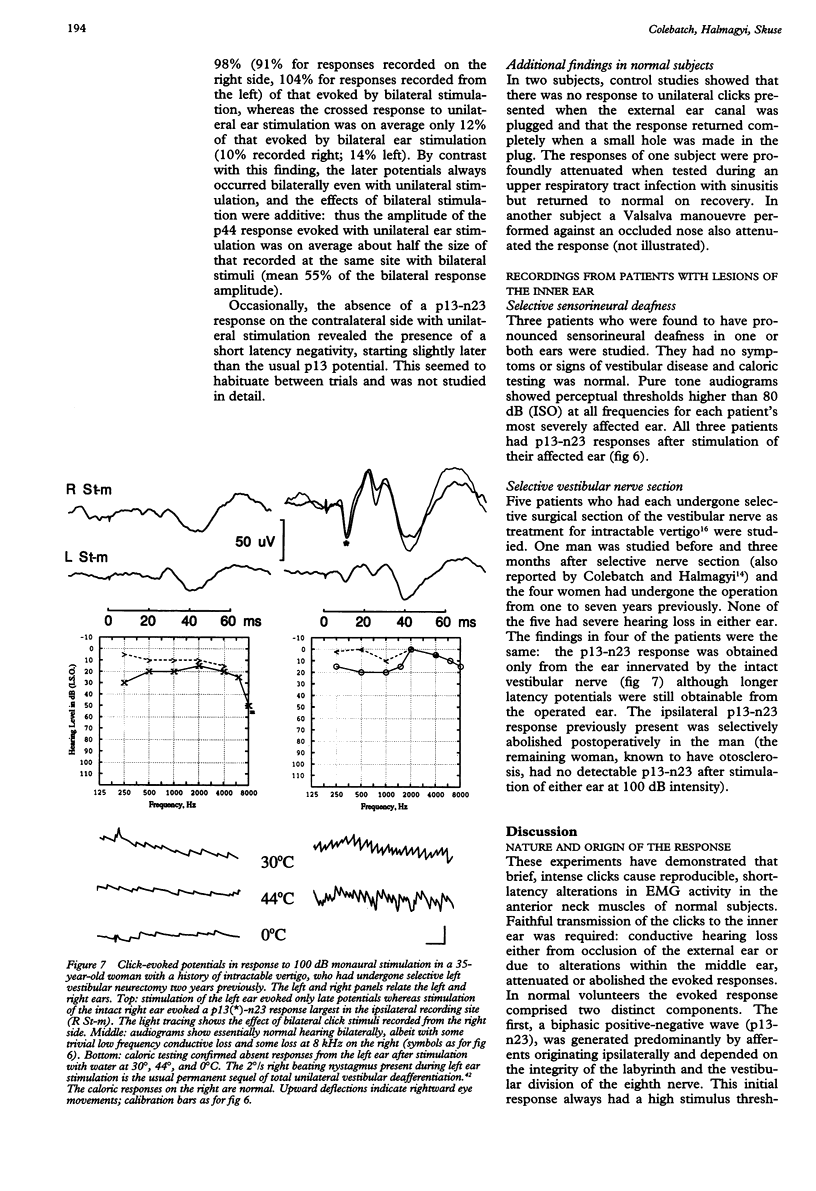
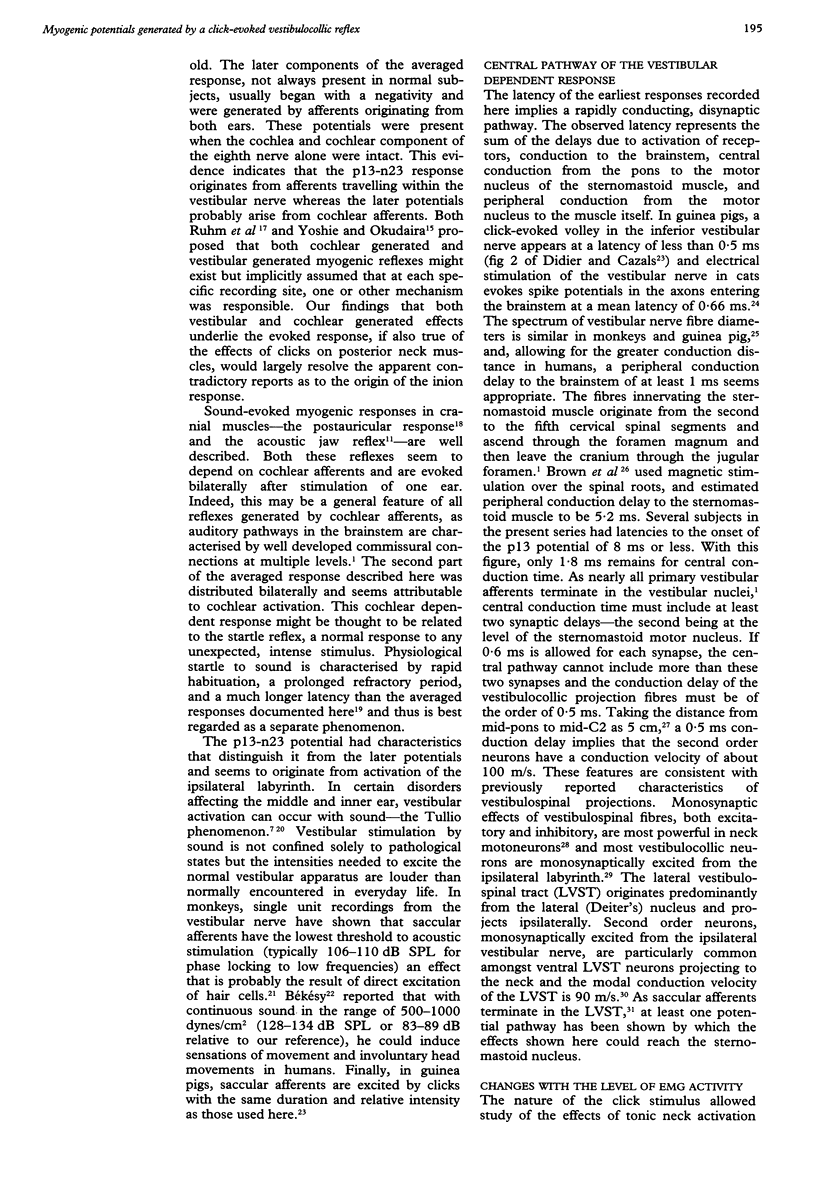
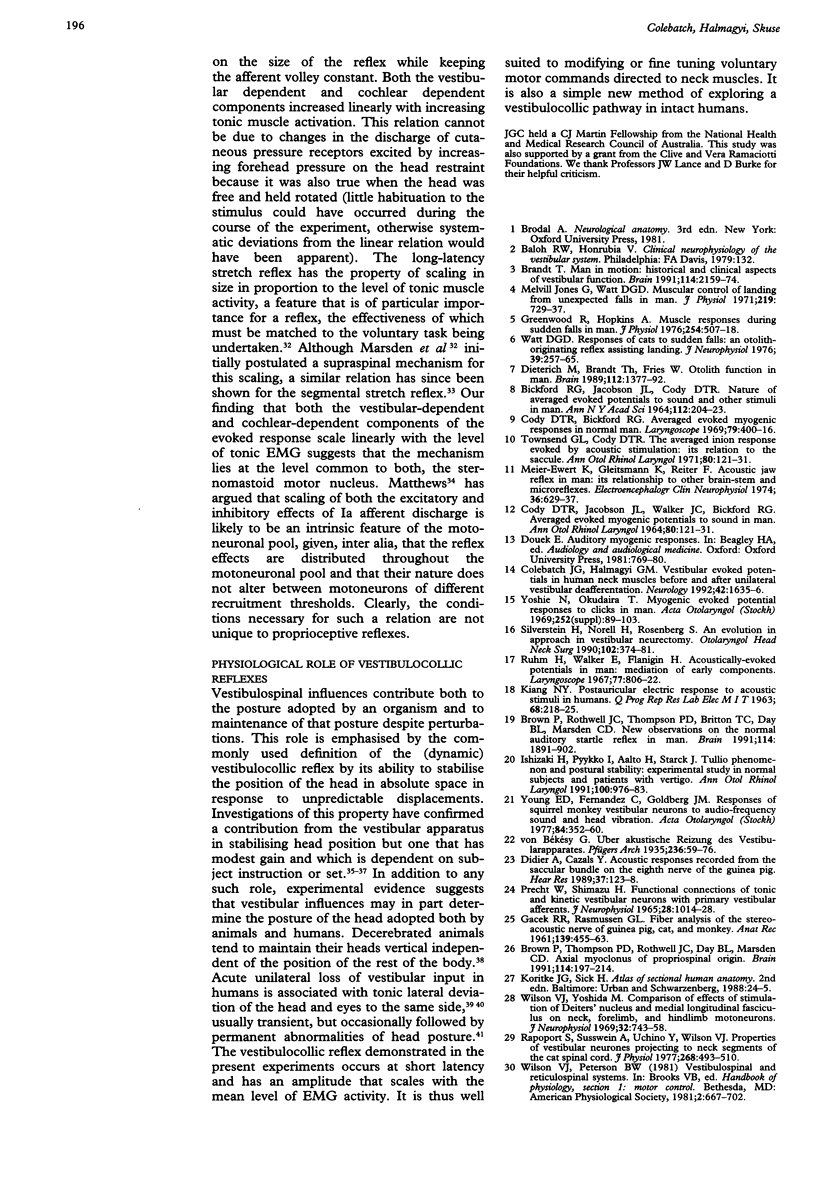
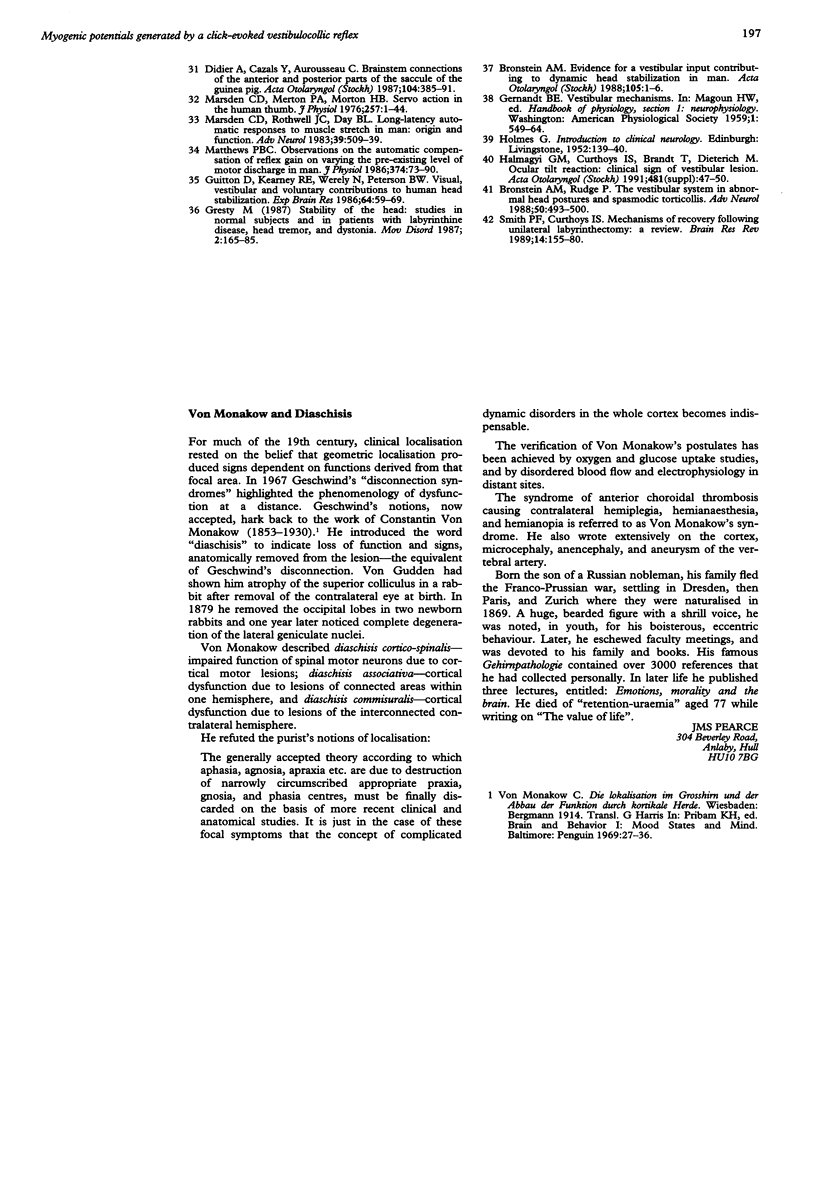
Selected References
These references are in PubMed. This may not be the complete list of references from this article.
- BICKFORD R. G., JACOBSON J. L., CODY D. T. NATURE OF AVERAGE EVOKED POTENTIALS TO SOUND AND OTHER STIMULI IN MAN. Ann N Y Acad Sci. 1964 May 8;112:204–223. doi: 10.1111/j.1749-6632.1964.tb26749.x. [DOI] [PubMed] [Google Scholar]
- Brandt T. Man in motion. Historical and clinical aspects of vestibular function. A review. Brain. 1991 Oct;114(Pt 5):2159–2174. doi: 10.1093/brain/114.5.2159. [DOI] [PubMed] [Google Scholar]
- Bronstein A. M. Evidence for a vestibular input contributing to dynamic head stabilization in man. Acta Otolaryngol. 1988 Jan-Feb;105(1-2):1–6. doi: 10.3109/00016488809119438. [DOI] [PubMed] [Google Scholar]
- Bronstein A. M., Rudge P. The vestibular system in abnormal head postures and in spasmodic torticollis. Adv Neurol. 1988;50:493–500. [PubMed] [Google Scholar]
- Brown P., Rothwell J. C., Thompson P. D., Britton T. C., Day B. L., Marsden C. D. New observations on the normal auditory startle reflex in man. Brain. 1991 Aug;114(Pt 4):1891–1902. doi: 10.1093/brain/114.4.1891. [DOI] [PubMed] [Google Scholar]
- Brown P., Thompson P. D., Rothwell J. C., Day B. L., Marsden C. D. Axial myoclonus of propriospinal origin. Brain. 1991 Feb;114(Pt 1A):197–214. [PubMed] [Google Scholar]
- Cody D. T., Bickford R. G. Averaged evoked myogenic responses in normal man. Laryngoscope. 1969 Mar;79(3):400–416. doi: 10.1288/00005537-196903000-00007. [DOI] [PubMed] [Google Scholar]
- Colebatch J. G., Halmagyi G. M. Vestibular evoked potentials in human neck muscles before and after unilateral vestibular deafferentation. Neurology. 1992 Aug;42(8):1635–1636. doi: 10.1212/wnl.42.8.1635. [DOI] [PubMed] [Google Scholar]
- Didier A., Cazals Y. Acoustic responses recorded from the saccular bundle on the eighth nerve of the guinea pig. Hear Res. 1989 Jan;37(2):123–127. doi: 10.1016/0378-5955(89)90034-8. [DOI] [PubMed] [Google Scholar]
- Didier A., Cazals Y., Aurousseau C. Brainstem connections of the anterior and posterior parts of the saccule in the guinea pig. Acta Otolaryngol. 1987 Nov-Dec;104(5-6):385–391. doi: 10.3109/00016488709128265. [DOI] [PubMed] [Google Scholar]
- Dieterich M., Brandt T., Fries W. Otolith function in man. Results from a case of otolith Tullio phenomenon. Brain. 1989 Oct;112(Pt 5):1377–1392. doi: 10.1093/brain/112.5.1377. [DOI] [PubMed] [Google Scholar]
- GACEK R. R., RASMUSSEN G. L. Fiber analysis of the statoacoustic nerve of guinea pig, cat, and monkey. Anat Rec. 1961 Apr;139:455–463. doi: 10.1002/ar.1091390402. [DOI] [PubMed] [Google Scholar]
- Greenwood R., Hopkins A. Muscle responses during sudden falls in man. J Physiol. 1976 Jan;254(2):507–518. doi: 10.1113/jphysiol.1976.sp011242. [DOI] [PMC free article] [PubMed] [Google Scholar]
- Gresty M. Stability of the head: studies in normal subjects and in patients with labyrinthine disease, head tremor, and dystonia. Mov Disord. 1987;2(3):165–185. doi: 10.1002/mds.870020304. [DOI] [PubMed] [Google Scholar]
- Guitton D., Kearney R. E., Wereley N., Peterson B. W. Visual, vestibular and voluntary contributions to human head stabilization. Exp Brain Res. 1986;64(1):59–69. doi: 10.1007/BF00238201. [DOI] [PubMed] [Google Scholar]
- Halmagyi G. M., Curthoys I. S., Brandt T., Dieterich M. Ocular tilt reaction: clinical sign of vestibular lesion. Acta Otolaryngol Suppl. 1991;481:47–50. doi: 10.3109/00016489109131342. [DOI] [PubMed] [Google Scholar]
- Ishizaki H., Pyykkö I., Aalto H., Starck J. Tullio phenomenon and postural stability: experimental study in normal subjects and patients with vertigo. Ann Otol Rhinol Laryngol. 1991 Dec;100(12):976–983. doi: 10.1177/000348949110001205. [DOI] [PubMed] [Google Scholar]
- Jones G. M., Watt D. G. Muscular control of landing from unexpected falls in man. J Physiol. 1971 Dec;219(3):729–737. doi: 10.1113/jphysiol.1971.sp009685. [DOI] [PMC free article] [PubMed] [Google Scholar]
- Marsden C. D., Merton P. A., Morton H. B. Servo action in the human thumb. J Physiol. 1976 May;257(1):1–44. doi: 10.1113/jphysiol.1976.sp011354. [DOI] [PMC free article] [PubMed] [Google Scholar]
- Marsden C. D., Rothwell J. C., Day B. L. Long-latency automatic responses to muscle stretch in man: origin and function. Adv Neurol. 1983;39:509–539. [PubMed] [Google Scholar]
- Matthews P. B. Observations on the automatic compensation of reflex gain on varying the pre-existing level of motor discharge in man. J Physiol. 1986 May;374:73–90. doi: 10.1113/jphysiol.1986.sp016066. [DOI] [PMC free article] [PubMed] [Google Scholar]
- Meier-Ewert K., Gleitsmann K., Reiter F. Acoustic jaw reflex in man: its relationship to other brain-stem and microreflexes. Electroencephalogr Clin Neurophysiol. 1974 Jun;36(6):629–637. doi: 10.1016/0013-4694(74)90229-6. [DOI] [PubMed] [Google Scholar]
- Precht W., Shimazu H. Functional connections of tonic and kinetic vestibular neurons with primary vestibular afferents. J Neurophysiol. 1965 Nov;28(6):1014–1028. doi: 10.1152/jn.1965.28.6.1014. [DOI] [PubMed] [Google Scholar]
- Rapoport S., Susswein A., Uchino Y., Wilson V. J. Properties of vestibular neurones projecting to neck segments of the cat spinal cord. J Physiol. 1977 Jun;268(2):493–510. doi: 10.1113/jphysiol.1977.sp011868. [DOI] [PMC free article] [PubMed] [Google Scholar]
- Ruhm H., Walker E., Jr, Flanigin H. Acoustically-evoked potentials in man: mediation of early components. Laryngoscope. 1967 May;77(5):806–822. doi: 10.1288/00005537-196705000-00009. [DOI] [PubMed] [Google Scholar]
- Silverstein H., Norrell H., Smouha E., Jones R., Rosenberg S. An evolution of approach in vestibular neurectomy. Otolaryngol Head Neck Surg. 1990 Apr;102(4):374–381. doi: 10.1177/019459989010200412. [DOI] [PubMed] [Google Scholar]
- Smith P. F., Curthoys I. S. Mechanisms of recovery following unilateral labyrinthectomy: a review. Brain Res Brain Res Rev. 1989 Apr-Jun;14(2):155–180. doi: 10.1016/0165-0173(89)90013-1. [DOI] [PubMed] [Google Scholar]
- Townsend G. L., Cody D. T. The averaged inion response evoked by acoustic stimulation: its relation to the saccule. Ann Otol Rhinol Laryngol. 1971 Feb;80(1):121–131. doi: 10.1177/000348947108000116. [DOI] [PubMed] [Google Scholar]
- Watt D. G. Responses of cats to sudden falls: an otolith-originating reflex assisting landing. J Neurophysiol. 1976 Mar;39(2):257–265. doi: 10.1152/jn.1976.39.2.257. [DOI] [PubMed] [Google Scholar]
- Wilson V. J., Yoshida M. Comparison of effects of stimulation of Deiters' nucleus and medial longitudinal fasciculus on neck, forelimb, and hindlimb motoneurons. J Neurophysiol. 1969 Sep;32(5):743–758. doi: 10.1152/jn.1969.32.5.743. [DOI] [PubMed] [Google Scholar]
- Yoshie N., Okudaira T. Myogenic evoked potential responses to clicks in man. Acta Otolaryngol Suppl. 1969;252:89–103. doi: 10.3109/00016486909120515. [DOI] [PubMed] [Google Scholar]
- Young E. D., Fernández C., Goldberg J. M. Responses of squirrel monkey vestibular neurons to audio-frequency sound and head vibration. Acta Otolaryngol. 1977 Nov-Dec;84(5-6):352–360. doi: 10.3109/00016487709123977. [DOI] [PubMed] [Google Scholar]


